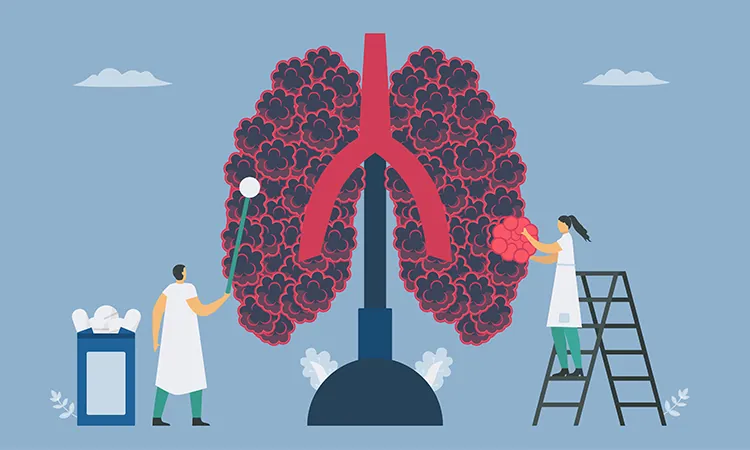
Revolutionary Breakthrough: Rapidly Reprogramming Fibroblasts into Lung Cells to Fight COPD
2025-07-11
Author: Siti
In a groundbreaking development, scientists at Nagoya University have unveiled a speedy and safe method to transform skin-like fibroblast cells into lung cells without the controversial use of stem cells. This innovation holds promise for creating new regenerative therapies targeting debilitating diseases such as chronic obstructive pulmonary disease (COPD).
A Game-Changing Technique for Lung Cell Production
The research team successfully generated lung cells akin to alveolar epithelial type 2 (AT2) cells from mouse embryonic fibroblasts in a remarkably short span of just 7 to 10 days. This new technique significantly outpaces traditional stem cell methods, which can take over a month to produce results.
The Critical Role of AT2 Cells
AT2 cells are vital for lung health as they produce surfactant and act as progenitor cells that facilitate alveolar repair. In patients with lung diseases like interstitial pneumonia and COPD, the loss or damage of these cells complicates recovery, making their regeneration essential for innovative treatments.
Moving Beyond Conventional Stem Cell Methods
Professor Makoto Ishii from the Nagoya University Graduate School of Medicine highlighted the limitations of previous induced pluripotent stem cell (iPSC) technology. Although iPSCs can regenerate AT2 cells in approximately one month, the process is expensive and poses risks such as tumor formation and immune rejection. "Our direct reprogramming method achieves faster results with reduced tumor risks and potential for patient-specific therapies," Ishii stated.
Decoding the Reprogramming Process
In a collaborative effort led by Ishii along with other researchers, the team set out to directly reprogram fibroblasts into AT2-like cells—a first in mice. Their innovative approach began by examining 14 genes related to lung development, and they discovered four specific genes—Nkx2-1, Foxa1, Foxa2, and Gata6—that effectively activated Sftpc, a key marker for AT2 cells.
Successful Cell Transformation and Validation
Introducing these genes into a 3D culture of genetically engineered mouse fibroblasts resulted in about 4% of the cells expressing the Sftpc/GFP marker in just 7 to 10 days. This new cell type has been termed induced pulmonary epithelial-like cells (iPULs). Further analysis revealed that iPULs exhibited characteristic features of AT2 cells and showed promising gene expression profiles akin to natural AT2 cells.
Transplant Success in Animal Models
To evaluate their functionality, researchers transplanted iPULs into the lungs of mice with interstitial pneumonia. Remarkably, after 42 days, the cells successfully integrated into the alveolar regions and some differentiated into alveolar epithelial type 1 (AT1)-like cells, crucial for gas exchange and lung repair.
A Leap Towards Human Applications
This pioneering technique for generating AT2-like lung cells from fibroblasts represents a significant milestone in the realm of regenerative medicine. With success demonstrated in mice, researchers are now setting their sights on translating this innovative method to human cells, aiming to develop a safe regenerative therapy utilizing a patient’s own fibroblasts. Professor Ishii concluded, "We have successfully reprogrammed fibroblasts into AT2-like cells in mice, and the next step is applying this technology to human cells to revolutionize treatment options for lung diseases."





 Brasil (PT)
Brasil (PT)
 Canada (EN)
Canada (EN)
 Chile (ES)
Chile (ES)
 Česko (CS)
Česko (CS)
 대한민국 (KO)
대한민국 (KO)
 España (ES)
España (ES)
 France (FR)
France (FR)
 Hong Kong (EN)
Hong Kong (EN)
 Italia (IT)
Italia (IT)
 日本 (JA)
日本 (JA)
 Magyarország (HU)
Magyarország (HU)
 Norge (NO)
Norge (NO)
 Polska (PL)
Polska (PL)
 Schweiz (DE)
Schweiz (DE)
 Singapore (EN)
Singapore (EN)
 Sverige (SV)
Sverige (SV)
 Suomi (FI)
Suomi (FI)
 Türkiye (TR)
Türkiye (TR)
 الإمارات العربية المتحدة (AR)
الإمارات العربية المتحدة (AR)